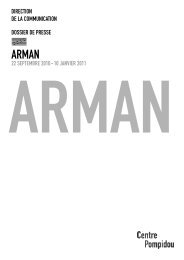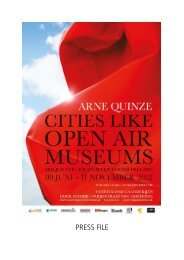Arman - Vicky David Gallery
Arman - Vicky David Gallery
Arman - Vicky David Gallery
Create successful ePaper yourself
Turn your PDF publications into a flip-book with our unique Google optimized e-Paper software.
12<br />
EXTRACT FROM THE CATALOGUE<br />
ARMAN BEFORE THE NEW REALISM<br />
Jean-Michel Bouhours<br />
Having studied at both the École des Arts Décoratifs in Nice and the École du Louvre in Paris, <strong>Arman</strong><br />
never tired of praising maieutic - the Socratic elicitation of the truth. In 1947 he met Claude Pascal and<br />
Yves Klein at the judo school in Nice; he was at the time the only one of the three to have in mind a career<br />
as a painter. A few years later came two major discoveries: the work of Jackson Pollock, at the only<br />
exhibition to be held in Paris during Pollock’s lifetime, at Studio Paul Facchetti in 1952; and the rubberstamp<br />
work of Hendrik Nicolaas Werkman, a Dutch artist close to the De Stijl group, through an article<br />
by Willem Sandberg published in the journal Art d’aujourd’hui. At the time, doing his military service at<br />
Antibes, <strong>Arman</strong> had let things slide; he was indeed planning a career as an artist, but his progress was<br />
erratic, if he had made any at all. He had been married for two years to Éliane Radigue, who herself had<br />
vague inclinations towards a career in music, and the couple were having difficulty in making ends meet.<br />
The year 1954 would prove a turning point. While holidaying with friends in Nice after returning from<br />
Japan, Yves Klein talked with <strong>Arman</strong> about his abstract painting and advised him to look for a more personal<br />
path. <strong>Arman</strong> grasped straight away the importance of finding an original language. And his visit to the<br />
Kurt Schwitters show at the Berggruen gallery in 1954 freed him from his attachment to oil painting. 1<br />
These key moments, as identified by <strong>Arman</strong> himself, set him on the road from an abstraction influenced<br />
by Serge Poliakov and Nicolas de Stael and on the way to the New Realism. 2<br />
This essay adopts a heuristic approach that will better enable us to understand how <strong>Arman</strong>’s most radical<br />
languages – those of the Accumulations and of the Poubelles or Garbage Cans – came to emerge. For this,<br />
we have to return to the period immediately preceding the inaugural declaration of New Realism.<br />
At the La Roue gallery in 1957, <strong>Arman</strong> showed his early abstracts and a few, small Cachets (rubber-stamp<br />
works). These new pieces marked the personal turn he had been advised to take by Klein, expressed in a<br />
gestural abstraction that took acting rather than making as its principle, privileging the act over the made.<br />
Pierre Restany saw in this a cathartic settling of accounts with the boring work that <strong>Arman</strong> had had to<br />
do in his father’s shop in Nice in order to survive. For <strong>Arman</strong>, the artistic gesture, if it were to be cathartic,<br />
had to be vigorous and repetitive; it derived from a repertoire that borrowed its rapidity of execution from<br />
the machine. In this, the artist affirmed the primacy of accident, disorder and subjectivity. The gesture is<br />
of the order of the spontaneous and obsessive action that for Harold Rosenberg defined action painting.<br />
When <strong>Arman</strong> writes to Eliane that he has a desire to rubber stamp every one of the many freckles she has<br />
on her body, he makes clear the sexual element in the gesture. There can be no doubt that Werkman’s<br />
work gave him ideas for his first Cachets: one again finds the same material, of course, the semantic/<br />
plastic construction, the repetition of an identical motif, the refusal of the decorative.<br />
There is one point, though, that needs to be made. <strong>Arman</strong>’s very first Cachets, dated in late 1954, which he<br />
showed at the La Roue gallery, were done not on paper like those that followed, but directly onto printed<br />
fabric. These first works, made entirely from waste materials – in terms of support as well as technique –<br />
declare, like Rauschenberg’s Combine Paintings, that all materials are pictorial. One might obviously<br />
argue that in <strong>Arman</strong>’s case economic necessity was the mother of artistic invention. His approach might<br />
also be seen as answering to the injunctions of Kurt Schwitters’ 1928 manifesto-essay, to make use of<br />
everything to be found in lumber rooms, on rubbish tips; the essay was reprinted in the catalogue of the<br />
exhibition at the Berggruen gallery that <strong>Arman</strong> had in his possession. 3 The artist brings into a situation<br />
of coexistence and tension two very different visual realities, a decorative floral motif printed by machine<br />
on a perfectly regular grid, very present in the composition in terms of colour and connotation, and the<br />
“overprinting” of a rubber stamp characterised by finesse of line, applied repeatedly, erratically and<br />
irregularly through human gesture. With the Cachets, the artist introduces a semiotic “overprinting” but<br />
also variation in repetition, accident and chance. In his 1948 essay on the new American painting, Clement<br />
Greenberg defined the new pictorial space at issue, highlighting the internal economy of all-over painting<br />
and the absence of variation in the repetition, by comparing Abstract Expressionist painting with wallpaper. 4<br />
It needed the critic Pierre Restany, writing in the journal Cimaise, to tell <strong>Arman</strong> to abandon the “limited<br />
format of boudoir frescoes” 5 for this “viscerally painterly Niçois” to make his own Cachets in much larger<br />
formats, filling the surface delimited by the frame. His first Cachets were done on samples of what<br />
Greenberg identified as the paradigm of the Abstract Expressionism that was in the process of dethroning<br />
easel painting. <strong>Arman</strong> in addition introduced a strong element of kitsch, distinguishing himself from<br />
the Modernism of Werkman or Schwitters by his refusal of the aesthetic. <strong>Arman</strong> repeats an identical<br />
administrative message, devoid of any typographic quality or second-order literary content. An astonishing




